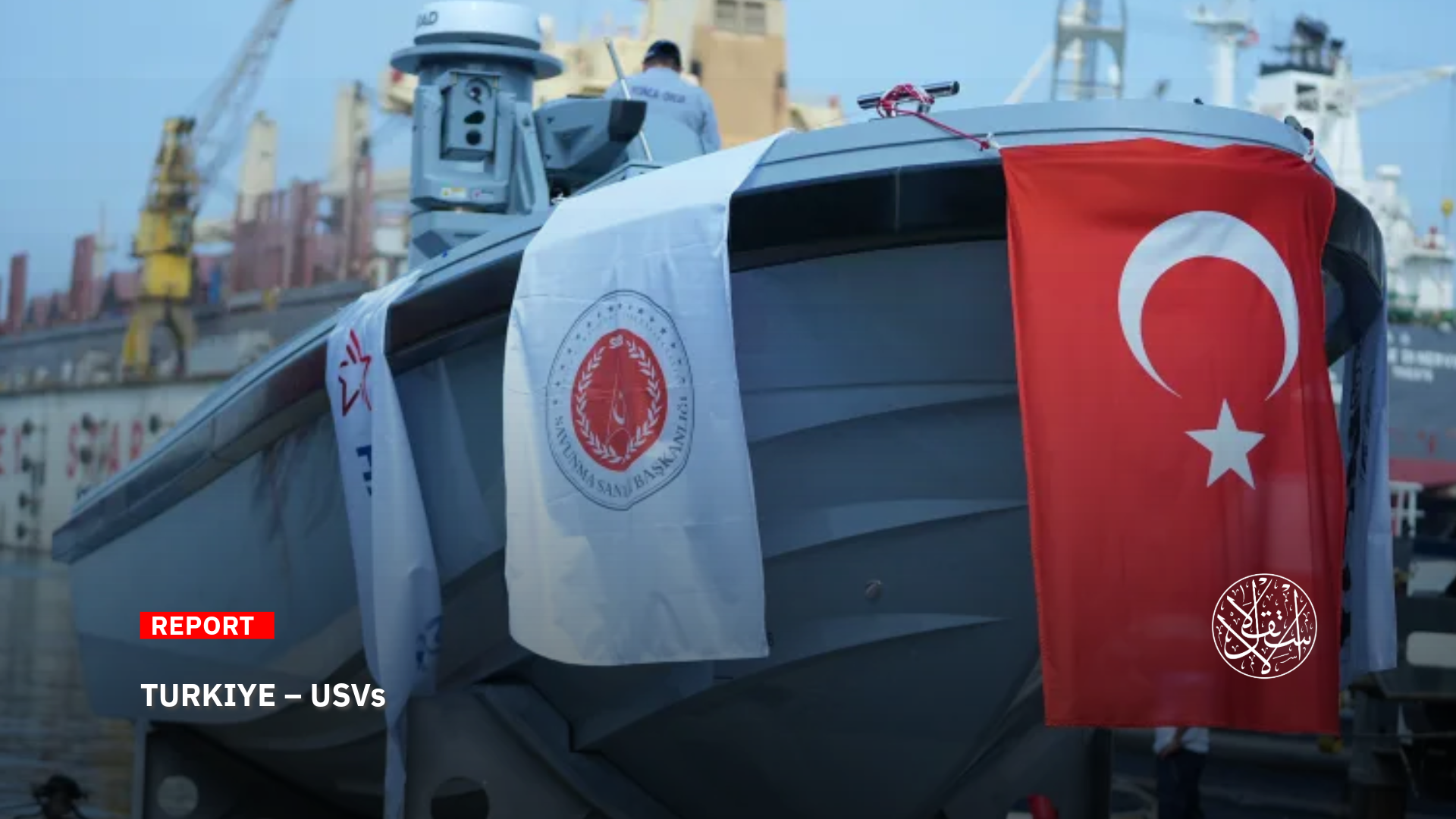After the Drone Revolution: How Turkiye Made a Significant Leap in the World of Unmanned Boats

Turkiye aims to become a global leader in unmanned surface vessels.
After making a significant impact in the field of unmanned aerial vehicles (UAVs), and achieving important tactical and strategic results, Turkiye has made another breakthrough by entering the world of unmanned surface vessels (USVs). These vessels have now become the latest deterrent weapon added to its naval arsenal.
This development came after years of work by leading Turkish defense companies, including Aselsan, Yonca-Onuk, and Havelsan.
This weapon is now ready for combat and engagement, playing a key role in future conflicts that Turkiye may face, particularly in its heavily contested maritime borders in the Mediterranean, where tensions with Greece and Greek Cyprus continue to rise.
Marlin SIDA
On September 12, 2024, TRT reported that the defense company Aselsan, in collaboration with shipbuilding company Sefine Tersanesi, developed the unmanned surface vessel Marlin SIDA.
Marlin SIDA boasts advanced technical specifications, making it the most powerful version of the modern Turkish unmanned vessel fleet.
Weighing 21 tons and carrying a payload of up to 4 tons, it has a range of nearly 1,000 nautical miles and can operate continuously for 72 hours.
The unmanned vessel is powered by two diesel engines and reaches speeds of up to 35 knots.

Regarding its armament, the Marlin SIDA can carry a variety of weapons, including a 12.7mm machine gun, several light torpedoes, and sonar systems.
Lutfi Gulk, the engineer in charge of unmanned and autonomous systems at Aselsan, noted that the unmanned vessel is capable of detecting and responding to electronic warfare and cyberattacks.
He added that the vessel’s control systems “enable a high level of automation through artificial intelligence.”
The systems are also capable of “receiving various data inputs that can be adjusted for different missions, providing a high level of automation through AI when needed,” according to TRT.
A key advancement for the Marlin SIDA is its new launch platform for "Kuzgun" missiles, which accommodates eight solid-fuel "Kuzgun-KY" missiles.
These missiles, developed by Tubitak-Sage, weigh 75 kilograms with a 10-kilogram warhead and a range of up to 20 kilometers.
Sancar Combat Vessel
Before Marlin SIDA, Turkiye entered the world of unmanned vessels on June 7, 2022, when the Turkish public and global audience witnessed the launch ceremony of the Sancar combat unmanned vessel, manufactured by Yonca-Onuk and Havelsan.
At the time, the President of the Defense Industries Agency, Ismail Demir, announced that “Turkiye aims to become one of the leading countries in the world in the field of unmanned surface vessels, benefiting from its expertise and success in armed unmanned aerial vehicles [combat drones]."
According to the Defense Industries Agency, Sancar features autonomous navigation, reaching speeds over 40 knots, with a minimum cruising range of 400 nautical miles.
It can sail for 40 hours non-stop without refueling, is 12.7 meters long, and boasts a modular design that allows for the integration of various systems.

The Sancar also boasts high maneuverability and speed, capable of performing its duties even in challenging weather and sea conditions.
It can transmit real-time images to command centers, detect and classify surface elements, and navigate independently, automatically avoiding stationary and moving obstacles, even when communication is lost.
It can also operate according to precise sensor coordinates.
Aselsan revealed that Sancar is equipped with Roketsan missiles and the fixed STAMP machine gun system, providing independent protection for naval bases and similar facilities.
Sancar can also integrate with UMTAS and L-UMTAS missiles, featuring a telescope, radar, camera, and anti-collision systems.
These unmanned vessels can be transported by cargo planes, military ships, or over land.
One of its most notable features, according to Aselsan, is its ability to perform combat and reconnaissance missions across four seas.
It can be equipped with a 7.62-meter caliber machine gun and a 40-meter grenade launcher.
SANCAR is capable of highly aggressive maneuvers without endangering civilians, thanks to its remote control system.
Albatros-S
Another important vehicle in Turkiye’s fleet of combat unmanned vessels is the Albatros-S, developed by Aselsan.
The Albatros-S excels in maneuverability and has advanced tactical network communication capabilities suited for the maritime environment, particularly in the Mediterranean Sea.
According to Aseslan, Albatros-S has a high payload capacity and can exceed speeds of 200 nautical miles per hour.
At around 7 meters in length, these vessels can continue operating safely against various obstacles and challenges.
They are equipped with advanced capabilities such as a local communication system, remote control, multi-communication system architecture, and the Global Navigation Satellite System (GNSS).
They can also continue their duties in a communication-disrupted environment and resist jamming during reconnaissance missions on enemy naval bases.

Erdogan's Threats
On September 16, 2022, Canada-based EurAsian Times published a report detailing Turkiye's aggressive strategy in entering the unmanned surface vessels arena and how it poses a threat to their primary rival, Greece.
The report highlighted that Turkiye’s “quest with Unmanned Surface Vehicles is not new. In May this year, the Salvo Armed Unmanned Surface Vehicle (AUSV), produced by Dearsan Shipyard, completed its first firing test activity. The test took place in collaboration with Aseslan, among other defense firms.”
In July 2021, Turkish defense companies Aseslan and Sefine Shipyard unveiled two designs for unmanned surface vessels. During the event, they began the steel cutting for the NB57, an anti-submarine warfare (ASW) USV, and initiated the first weld for the RD09, a variant designed for anti-surface warfare.
The report emphasized the importance of these unmanned vessels in Turkiye's naval warfare capabilities for both defensive and offensive operations, especially in light of rising tensions between Ankara and Athens. EurAsian Times noted that the strategic value of these vessels grows as the conflict between Turkiye and Greece escalates.
Ankara claims that Athens is violating international agreements by militarizing islands near Turkiye's Mediterranean coast. Turkiye’s coast guard accused Greece’s coast guard of opening fire on a cargo ship sailing in international waters in the Aegean Sea.
The report further explained that, in such scenarios, the development and deployment of unmanned maritime vessels are crucial for Turkiye. On September 3, 2022, Turkish President Recep Tayyip Erdogan issued a veiled threat of “invasion” against Greece, prompting Athens to declare its readiness to defend its sovereignty. Territorial disputes in the Aegean Sea and disagreements over airspace boundaries remain unresolved between the two countries.
The report concluded that before Turkiye’s military-industrial revolution, Greece was equipped with advanced fighter jets like France's Rafale and upgraded U.S. F-16s, while Turkiye lagged behind with an aging fleet. However, the current situation has shifted dramatically in favor of Ankara's ambitions.
Sources
- After Bayraktar Drones, Turkey Now Launches World’s 1st EW-Capable Unmanned Surface Vessel — Reports
- Equipped with Missiles: Discover the Turkish Unmanned Vessel 'Marlin Sida' []Arabic
- With 'Sangar' as a Model: How Unmanned Vessels Safeguard Turkiye Across Three Surrounding Seas [Arabic]
- Turkish Naval Drones: Exceptional Capabilities and Maximum Protection for the Blue Homeland [Arabic]
- UNMANNED SURFACE VESSELS [Turkish]
- The 'Intelligence' of Unmanned Surface Vessels Passes Its First Test" [Turkish]












